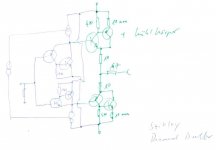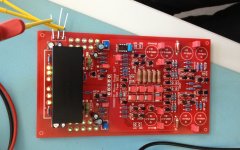This is called class XD crossover displacement technology and is described in his Audio Power Amplifier Design Handbook, 5th edition from page 328 to 343.
When you apply an current (let’s say to -Vmain) then this will be compensated by the amp halve connected to +Vmain, the amp halve to -Vmain will still be without bias. So that is 'halve' a solution. I think the solution may be to change the output nmos into a current source (let’s say 100 mA) this can be done by adding a reference (voltage drop along an diode) a drain resistor an opamp and some circuitry to add the outputs of the voltage controller amp and the current controller amp (in some manner
You know that i like to play with buffers. We need them for our kind of phono stages and they are useful for line stages, active filters and driving headphones to mention only a few duties. You may think : why another buffer ? The driven cascode buffer in the original Pardise proved to work, the oscillation problem came from decoupling issues in the mirrors. Also the floating J-Fet buffer in the new Paradise works just fine. It is one of the most " not there " circuit i ever NOT heard.
What can happen on the other hand that we need more juice then the J-Fet buffer can supply, for example for low impedance headphones, or there are no J-Fets in the house.
In that case the circuit i will show could be a solution. Here i simply substituted the BJTs in a Current Mirrored Diamond Buffer with CFB ( also called Szikley ) pairs. A Szikley pair has very high current gain like a Darlington, 100% local feedback and only one Ube drop in the signal chain. I found an older hand drawing i had made with a Szikley output stage and just added the input stage today. Funny, that this arrangement did not occur to me in the first place. The circuit is only a concept so values of the resistors may change.
What can happen on the other hand that we need more juice then the J-Fet buffer can supply, for example for low impedance headphones, or there are no J-Fets in the house.
In that case the circuit i will show could be a solution. Here i simply substituted the BJTs in a Current Mirrored Diamond Buffer with CFB ( also called Szikley ) pairs. A Szikley pair has very high current gain like a Darlington, 100% local feedback and only one Ube drop in the signal chain. I found an older hand drawing i had made with a Szikley output stage and just added the input stage today. Funny, that this arrangement did not occur to me in the first place. The circuit is only a concept so values of the resistors may change.
Attachments
Actually the guy that invented it is called "Sziklei".
Sziklai pair - Wikipedia, the free encyclopedia
Sziklai pair - Wikipedia, the free encyclopedia
Here is some good information how to design a Sziklei Class AB current amp :http://www.tedpavlic.com/teaching/osu/ece327/lab7_proj/lab7_proj_procedure.pdf
I have described it here before but under the name "Diamond Dove".
We have elaborated here before that it is virtually impossible to make an active stage that has lower noise then 0,3nVqHz, that is approximate the noise of a 5 Ohm resistor.
And there is 1/F or flicker noise so in praxis the noise goes up when the frequency goes down. In J-Fets and tubes the corner frequency can be as high as 1kHz and with bipolars as low as 10Hz so bipolars do better in this regard but they can have shot noise or popcorn noise.
Of cause the noise of a 5 Ohm resistor is not much and the cartridge produces noise too.
For example the DENON DL103 has a DC impedance of around 40 Ohm so produces much more noise itself then for example the Paradise.
The development of the Primal Scream was triggered on the other hand by a new breed of cartridges that have extremely low DC resistance. An older example is the Audio Note IO and some new ones are the Lyra Atlas ( 4 Ohm ) and the My Sonic Lab ( 2 Ohm ).
One solution is a transformer. Good ones have under 1 Ohm primary DC resistance and no 1/F noise. The problem with transformers is that they can saturate in the bass so distortion goes up with level and the deeper it goes and in the treble they have a roll off, mostly accompanied by a peak before the rolloff.
What i do in the Primal Scream is to use a passive I/U converter that you could also call a transformer like structure and put that into a differential feedback loop.
That way i get a very extended frequency response and the distortion is hold under control too.
I have also published measurements.
The noise baseline is at -160dBU and the upper frequency limit is -3dB at 360kHz, the null in my Anti RIAA, so it tracks the RIAA perfectly.
We have elaborated here before that it is virtually impossible to make an active stage that has lower noise then 0,3nVqHz, that is approximate the noise of a 5 Ohm resistor.
And there is 1/F or flicker noise so in praxis the noise goes up when the frequency goes down. In J-Fets and tubes the corner frequency can be as high as 1kHz and with bipolars as low as 10Hz so bipolars do better in this regard but they can have shot noise or popcorn noise.
Of cause the noise of a 5 Ohm resistor is not much and the cartridge produces noise too.
For example the DENON DL103 has a DC impedance of around 40 Ohm so produces much more noise itself then for example the Paradise.
The development of the Primal Scream was triggered on the other hand by a new breed of cartridges that have extremely low DC resistance. An older example is the Audio Note IO and some new ones are the Lyra Atlas ( 4 Ohm ) and the My Sonic Lab ( 2 Ohm ).
One solution is a transformer. Good ones have under 1 Ohm primary DC resistance and no 1/F noise. The problem with transformers is that they can saturate in the bass so distortion goes up with level and the deeper it goes and in the treble they have a roll off, mostly accompanied by a peak before the rolloff.
What i do in the Primal Scream is to use a passive I/U converter that you could also call a transformer like structure and put that into a differential feedback loop.
That way i get a very extended frequency response and the distortion is hold under control too.
I have also published measurements.
The noise baseline is at -160dBU and the upper frequency limit is -3dB at 360kHz, the null in my Anti RIAA, so it tracks the RIAA perfectly.
wow, these are impressive figures.
On the new paradise, power supply worked at first turn-on, take a look! No external load resistor needed, the shunt is enough load in itself. The heatsink doesnt get very warm (I had +/-30V at the input, current was 120mA each).
Hope to have good news on the amplifier section soon.......
On the new paradise, power supply worked at first turn-on, take a look! No external load resistor needed, the shunt is enough load in itself. The heatsink doesnt get very warm (I had +/-30V at the input, current was 120mA each).
Hope to have good news on the amplifier section soon.......

